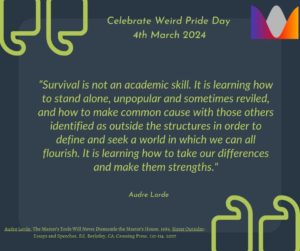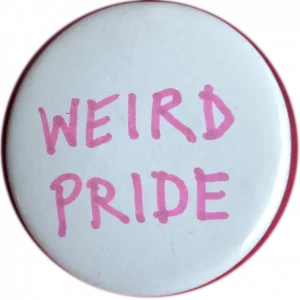by Fergus Murray
Weird Pride Day started in 2021, but its roots go back a long way before that.
The use of pride as a political tool originated in the movement for Black liberation in the 1960s. It was a response to racism: to being made to feel ashamed and lesser. Pride, in a political sense, has always been chiefly about the negation of shame.

The Gay Pride movement consciously drew on the language and tactics of the Black liberation movement. Both groups were denied civil rights and faced massive discrimination; there were helpful parallels between these struggles. There was also significant overlap: racism and transphobia were major components of the police persecution that led to the Stonewall riots, which kick-started the movement for queer liberation.
As Gay Pride spread around the world, and the inadequacy of the term ‘gay’ became ever clearer, the word ‘Pride’ on its own ended up being widely used for LGBTQIA+ Pride. Many other pride movements have coexistes alongside it, though: Disability Pride, Mad Pride, Autistic Pride and so on.
The idea of Weird Pride in particular is one that seems to have been formulated independently a few times, largerly by autistic people (search ‘WeirdPride’ on social media sites and you’ll find various examples). A 2008 profile of the late Mel Baggs in Wired adapted the famous Queer Pride slogan: “We’re here. We’re weird. Get used to it.” I hadn’t seen that when I wrote a piece with that title in 2019.

My mother Dinah Murray, who worked with Baggs and others on the film ‘Something About Us‘, probably made her first Weird Pride badge some time before that, and liked to wear it prominently at formal events about autism. She wrote in 2005 about how her background had allowed her to be proudly weird throughout her life, in her book chapter ‘One that got away.’
In 2021, after her cancer diagnosis, we talked about the idea of starting a Weird Pride Day. I chose the 4th of March so that it was far enough away from the big LGBTQ+ Pride celebrations to avoid confusion, without being in the dead of winter; and because some people will say this date as ‘March Fourth’, and I like the image of people marching forth with their weirdness proudly on show.
For Weird Pride Day in 2021, Autistamatic made a promo video and we collaborated on designing the Weird Pride flag. He also helped with admin on the Weird Pride Day Facebook page, together with Ausome Charlie; we invited and shared content from around the world, NeuroClastic published a few pieces and Saided DePriest translated a few things into Spanish. In 2022 and 2023, AMASE and ARGH ran Lightning Talks online – some of the 2022 talks are on our Videos page, along with the panel discussion hosted by David Gray-Hammond, who has been involved since the first year.
More people have taken part every year, and we look forward to even more folk (from more different communities) marching forth weirdly in the future.
